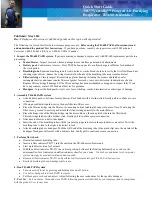
Maintenance and service
WARNING
Disconnect and lock out power when servicing unit. Failure to do so may result in personal injury or
death due to electrical shock.
CAUTION
Exercise care when working around the sharp metal edges of door panels or door frames, etc. These
edges can cause injury.
Evaporator and condenser coils
Inspect the evaporator coil at filter change intervals. Inspect the condenser coil at least semi-
annually. A dirty condenser coil results in elevated condensing pressures and poor unit
performance. Dirty or clogged evaporator coils cause low suction pressure and lost capacity. If the
coils appear dirty, clean them using a mild detergent or a commercial coil cleaning agent.
Refrigerant circuits
During unit operation, check and record the compressor discharge and suction pressures. Also
record the compressor running current. A maintenance log of these readings can indicate if the
unit is operating within its normal limits. Investigate abnormal readings and correct the cause.
Blowers
Inspect both the evaporator and condenser blowers at each regular service interval. As required,
clean the blower wheels. Bearings are a permanently sealed ball type and do not require
lubrication. Check the bearings for signs of wear (movement between the inner and outer races).
Ensure that the bearing locking collars are secure to the shaft and that the collar locking screw
is properly set. Check that the blower wheel is tight on the shaft and that the hub set screws are
properly torqued.
Drive belts
Examine the belts periodically for wear. Glazed areas on the drive surfaces indicate overheating
due to belt slippage. The ideal tension is the lowest tension at which the belt does not slip under
peak load conditions. Over-tensioning shortens the belt and bearing life (see
Adjust the tension on the belt for a deflection of 1/64-inch per inch of belt span, with the
appropriate force applied at the midpoint of the span. Tension new belts at the maximum value
indicated. Maintain used belts at the minimum value.
Filters
Inspect the filters monthly and replace them as required. Use UL Class 2 rated filters. Factory
supplied filters are the medium efficiency, extended surface pleated type. To maintain optimum
airflow performance, ensure the replacements are of the same type. See Table 31 for filter sizes.
49
Model DSH024C–120C Horizontal R-410A Air Conditioning Units C-Generation Smart Equipment Controller
Johnson Controls
















































